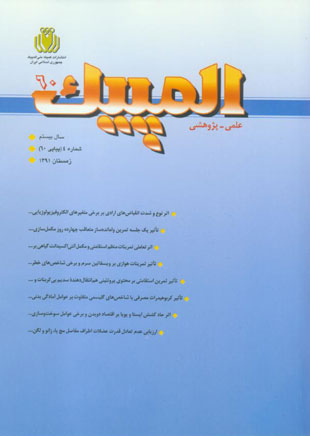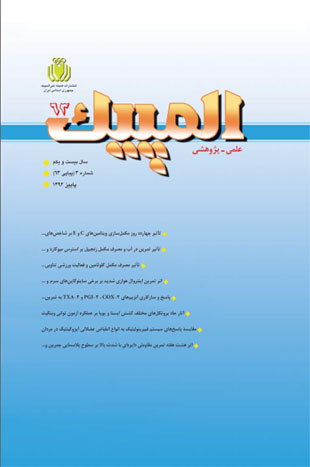فهرست مطالب

فصلنامه المپیک
سال بیستم شماره 4 (پیاپی 60، زمستان 1391)
- 136 صفحه، بهای روی جلد: 10,000ريال
- تاریخ انتشار: 1392/02/15
- تعداد عناوین: 8
-
Page 7The purpose of this study was to determine the effect of type and intensity of voluntary contractions on some of vertical jump's electrophysiological variables. The subjects were 12 trained track and field athletes. The subjects performed one set of dynamic or isometric half-squat using maximal (MD= Maximal Dynamic half-squat, MI= Maximal Isometric half-squat for 7 seconds), submaximal (SD= Submaximal Dynamic half-squat, SI= Submaximal Isometric half-squat for 4 seconds), and a control (C) warm up condition on randomized separating conditions over the course of different 5 days. After a 5 minutes post-protocols, the subjects completed a vertical jump test (VJ). The electromyographic (EMG) activity of quadriceps (Qc) and hamstring (H) were recorded during the concentric phase of the jumps. A one way ANOVA with repeated measures on the one factor was used to analyze the data. The results of this study indicated that the vertical jump height had improved significantly (p ≤ 0.05) after MD (10.58%), SD (10.53%), and SI (7.79%) protocols compared to C. No significant differences were found among the repeated measures in Qc and H activity (p > 0.05). It is concluded that the use of a specific warmup that includes half-squats, performed with submaximal to maximal intensity, improves VJ performance that seems to be more related to the intramuscular changes.Keywords: Countermovement Vertical Jump, EMG Activity, Postactivation Potentiation, Voluntary Contraction
-
Page 19The aim of this study was to determining the effect of onesession exhausting training and 14-day Coenzyme Q10 supplementation on plasma lactate and serum total creatine kinase (CK) response in elite male rock climbers. Eighteen elite male rock climbers (aged 21±3 years, and body fat 6±2 % and VO2max 52±4) in a randomized and double-blind design were allocated in two equal groups: supplement group (n=10, Coenzyme Q10: 2.5 mg/kg/day) and placebo group (n=10, Dextrose: 2.5 mg/kg/day). After supplementation period, all subjects were participated in an exhausting rock climbing training. Blood samples obtained before the Q10 supplementation along with immediately before and after the protocol, respectively. Plasma lactate and serum total creatine kinase were determined by automatic analyzers. Data were analyzed by repeated measure ANOVA, Bonferroni and independent t test at α≤0.05.The results show that short-term Coenzyme Q10 supplementation has no significant effect (P>0.05) on Basal param- eters. However, plasma lactate and serum total CK were significantly increased (P<0.05) after the training protocol. Nevertheless, the exhausting exercise-induced increase in plasma lactate and serum creatine in supplement group was less than in placebo group (P<0.05). Based on the results, it can be concluded that 14-day Coenzyme Q10 supplementation can reduce exhausting exercise-induced lactate and creatine kinase response (Metabolic and Mechanical indices) in elite male Lead rock climbers.Keywords: Coenzyme Q10, Lactate, Rock Climbing Training, Total Creatine Kinase
-
Page 31For the study of interactive effects of endurance exercise and plant anti oxidant supplement on inflammatory markers, including vascular adhesive molecules (VCAM-1) and reactive protein with high sensitivity (HS-CRP) and antiinflammatory such as angiotensin converting enzyme inhibitors (ACE-I) in the hypertensive caused by induction of nitric oxide synthase inhibitors (iNOS), 48 mice randomly dividede into six groups: 1) basic, 2) sham, 3) iNOS 4) Ferula gummosa boiss 5) endurance 6) Ferula gummosa boiss+exercise. Groups 3 to 6, five sessions per week for eight weeks, 10 mg / kg dissolved iNOS were as the peritoneal. Group 5 and 6 endurance running exercise protocol on a treadmill with a speed of 15 to 20 meters per minutes 5 times a week for 8 weeks were performed.Group 4 and 6, 90 mg / kg 5 times a week using a solution of Ferula gummosa boiss gavage for 8 weeks and group 2 received saline with same conditions. The laboratory and statistical analysis revealed that induction of iNOS leads to hypertensive and reduced the angiotensin converting enzyme inhibitors ACE-I. Furthermore, hypertensive was associated with increase at vascular adhesive molecules (VCAM-1) and HS-CRP. The exercise protocols and Ferula gummosa boiss was only inhibit the harmful effects of hypertensive associated with induction of iNOS. However, using the combined method (endurance training+ Ferula gummosa boiss) can reverse the effects of basic and sham groups were compared. Based on these results, hypertensive is associated with vascular damage, and a combination of regular activity and ani-oxidative supplements can be used as a non-medical strategies to control and combat the effects of chronic hypertensive.Keywords: Hypertensive, Adhesive Molecules, Endurance Training, Cardiovascular Events, Antioxidant
-
Page 45Recent studies indicate that visfatin is a newly identified adipocytokine, which increases with obesity and may have potential proinflammatory effects. Since, the relationship between serum visfatin level with metabolic syndrome and aerobic training has not been clearly established. The aim of this study is to investigate the effect of an aerobic training on serum visfatin levels and some risk indices of metabolic syndrome in obese men.Twenty obese males volunteered and were divided randomly into the experimental (n=10) and control (n=10) groups. Aerobic training protocol consisted of 3 sessions per week for 10 weeks. Each training session consisted of one slow running trial with an intensity of 65 to 75 percent of maximal heart rate for a period of 10 minutes. In order to follow the principle of overload, halfa- minute was added to each session, so that, at the last session the running time reached to 25 minutes. Before and after the training period, blood sampling was performed. Data were analyzed using independent t-test. Results showed significant reduction of serum visfatin level, and no signifi- cant difference in insulin resistance index, serum LDL, TC and TG between the control and experimental groups. In addition, aerobic training reduced significantly body mass index, body weight, waist to hip ratio, body fat percent, and increased significantly HDL and maximum oxygen uptake. It can be said that 10 weeks of aerobic training can cause significant reduction of serum visfatin, but these reduction is not associated with improved indicators of metabolic syndrome as insulin resistance and lipid profileKeywords: Aerobic Training, Insulin Resistance, Metabolic Syndrome, Obesity, Visfatin
-
Page 61The purpose of this study was to investigate the effect of endurance training on muscle NHE1 and NBC1 protein contents in rat.Male vistar rats (n=20), 4 weeks age and 95.7±10.8 g in weight were selected and divided into control and training groups randomly. Endurance training were performed for 7 weeks that be started with relatively low speed and duration (20m⁄min and 20 min respectively) in the first week and reached to 30m⁄min and 35min gradually in the last week. NHE1 and NBC1 protein contents determined by western blotting technique in Soleus as a red (oxidative) and EDL as a white (glycolytic) muscle preparation. The Levene’s test was used for equality of variances and the between groups differences in variables were determined by independent t test. NHE1 content increased in soleus and EDL in trained group by 32% and 31% respectively in compare with control (P<0.05). NBC1 content also was increased in Soleus and EDL in trained group by 20% and 34% respectively (P<0.05). In conclusion, these result showed that endurance training increased NHE1 and NBC1 contents in oxidative and glycolitic fibers. Therefore, endurance training may improve the capacity for pHi regulation in skeletal muscle by lactate independent pathway.Keywords: Cotransporter, Endurance Training, Na, H Exchanger, Na, HCO3 pHi regulation
-
Page 75The aim of this study was to investigate the effect of consumed carbohydrate usage with different glycemic index on physical fitness in 15 to 17 years old boys. Study population of this study was the entire high-school boy with the age range of 15 to 17. Study sample was 60 students with the age range of 15 to 17 selected randomly from among Ayatollah Khamenei high-school in Meshkinshahr. Samples were divided randomly into three groups, each group including 20 students. The first group had high glycemic index with age mean of 15.22±1.8 years, height mean of 170±6.92 Cm, weight mean of 60.98±9.49 kg and BMI of 15.23±4.91. The second group had Moderate glycemic index with age mean of 15.36±1.33 years, height mean of 169±5.05 Cm, weight mean 59.01±7.89 kg, and BMI of 12.45±3.68. The third group had low glycemic index with the age mean of 15.32±1.40 years, height mean of 168±5.18 Cm and weight mean of 58.42±8.66 kg, and BMI of 14.10±4.44. They were selected to measure physical fitness such as chain ups. Sit ups, run540m and flexibility. All of the Groups did the three hours same exercises and then after 2 days they were tested. The statistical method (ANOVA) was used to analyze the data. Tukey, Levine and Kolmogorov-Smirnov tests were used to assess inter-group differences, assess homogeneity of variances and assess natural distribution respectively within SPSS 16 software. The results showed that there was a significant difference between sit ups after eating breakfast with low and Moderate glycemic index and high glycemic index. Besides, there was significant difference between physical fitness of low glycemic index and high glycemic index after eating breakfast. But, there was no significant difference in flexibility index among three groups (P≤0.01).Base on the data collected; better results have been seen in evaluating physical fitness factors related to health by mean of consuming carbohydrate with low glycemic.Keywords: Carbohydrate, Glycemic Index, Physical Fitness
-
Page 85The purpose of this study was to determine the effects of static and dynamic stretch exercise on running economy and some of metabolic parameters of submaximal activity \ in active women. 16 active women from physical education college (Mean±SD: age: 23.87±1.62 yr; weight: 57.20±7.84 kg, height: 163.46±6.23 cm, body fat: %23.96±2.70 and Vo2max: 42.15±3.41 ml.kg-1.min-1) participated in this study voluntary. After measurement of Vo2max and LT, the subjects performed two protocols of stretching (static and dynamic) and one protocol without stretching before submaximal activity (treadmill running at 70% Vo2max) in three separate sessions. Respiratory gas exchange was measured by gas analyzer and time constants (τ1, τ2, τ3) were calculated from O2 kinetics graph. Results of Repeated measure ANOVA and LSD tests showed that, steady state oxygen uptake (ml/kg/min) increased significantly after static stretching in comparison with no stretching (P=0.037), but there were no significant difference between dynamic stretching and control (P=0.096) and between dynamic and static stretching (P=0.333). Also, Ventilation increased significantly (P<0.05) after both static and dynamic Stretching. Statistical analysis revealed no significant difference in other variables (CO2, RER, τ1, τ2, τ3) (P>0.05). therefore, The result show that static stretching decreases running economy, so it is suggested that, static stretching not to be performed before submaximal running.Keywords: Metabolic Factors, Running Economy, Static, Dynamic Stretching, Submaximal Activity, Time Constants of O2 kinetic
-
Page 99The propose of this study was assessment of the muscle strength imbalance of ankle, knee and hip joints as one of the important biomechanical factors in predicting of lower limbs sport injuries among young elite athletes. The number of 45 male of the soccer players, Track & Field and Woshu from Zanjan clubs (mean ± SD; age 17.6 ±2.1 Y, weight 63.3 ± 10.8 Kg, height 172.5 ± 10.3 Cm) were randomly selected. Muscle strength were measured using isotonic machines (DYNAFORCE) and 1RM. Injures were collected by a questionnaire. Result of this study showed the relationship between muscle imbalance selected in ankle, knee and hip joints with muscle injuries were significant (P<0.05). There were significant relationship of the coordination between muscle strength (ankle plantar flexor/ dorsi flexor), (hip addactor/abdactor),(knee flexor/ extensor) with muscle injuries in dominant - nondominant legs (P<0.05). In conclusion that, reciprocal and bilateral muscles strength imbalance of ankle, knee, and hip joints of dominant - nondominant legs are one of the most important factors in muscle injury and also, the data of present study can be help to trainers, coaches, players and clubs managers in designing program prevention of injury.Keywords: Isotonic Strength, Lower Limbs, Muscle Imbalance, Muscle Injury, Young Elite Athletes


